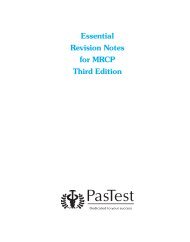EMQs for Medical Students - PasTest
EMQs for Medical Students - PasTest
EMQs for Medical Students - PasTest
Create successful ePaper yourself
Turn your PDF publications into a flip-book with our unique Google optimized e-Paper software.
E M Q s F O R M E D I C A L S T U D E N T S – V O L U M E 2<br />
are invariable clinical features. This is another surgical emergency that is an indication<br />
<strong>for</strong> emergency laparotomy (usually with oversewing of the ulcer) after attention has<br />
been paid to fluid and electrolyte replacement.<br />
9. ABDOMINAL MASS<br />
1. I – Pancreatic pseudocyst<br />
This patient has a pancreatic pseudocyst. This is a collection of pancreatic secretions<br />
that collect in the lesser sac, and is caused by pancreatitis (it is one of the classic<br />
complications of pancreatitis). The patient might give a history of acute pancreatitis or<br />
might present with epigastric fullness, pain, nausea and, sometimes, vomiting. Such<br />
cysts can become complicated by infection or haemorrhage.<br />
2. B – Carcinoma of the head of the pancreas<br />
This patient has a carcinoma of the head of the pancreas. The history and findings are of<br />
obstructive jaundice with a palpable gallbladder. Courvoisier’s law states: ‘When the<br />
gallbladder is palpable and the patient is jaundiced the obstruction of the bile duct<br />
causing the jaundice is unlikely to be a stone because previous inflammation will have<br />
made the gallbladder thick and non-distensible.’ While there are a few exceptions to<br />
this rule, the history of substantial weight loss and of pain radiating to the left side of the<br />
back strongly indicate the likelihood of pancreatic carcinoma – the commonest cause<br />
of malignant biliary obstruction.<br />
3. D – Carcinoma of the sigmoid colon<br />
This patient has a carcinoma of the sigmoid colon. The patient has presented with a<br />
late complication of the disease, ie extensive hepatic metastasis sufficient to obstruct<br />
biliary drainage. Colorectal cancer is the commonest cause of such intrahepatic<br />
obstruction. The patient there<strong>for</strong>e has two masses – the primary in the left iliac fossa<br />
and hepatomegaly.<br />
4. F – Cirrhosis of the liver<br />
This patient has cirrhosis of the liver. She has presented with features of portal hypertension<br />
(decreased level of consciousness due to hepatic encephalopathy, ascites and<br />
haematemesis secondary to oesophageal varices). The liver is enlarged (the palpable<br />
mass) and she is jaundiced. Alcoholic liver cirrhosis is the commonest cause of<br />
jaundice and portal hypertension in the developed world.<br />
5. H – Gallstone disease<br />
This patient has gallstone disease. This has become complicated by an empyema of the<br />
gallbladder. The gallbladder distension is caused by a stone obstructing the cystic duct,<br />
and the subsequent empyema (pus in the gallbladder) by infection of the stagnant bile.<br />
This mass is palpable in the right upper quadrant and associated with a systemic febrile<br />
illness. The patient is not jaundiced because the common bile duct and hepatic ducts<br />
are not obstructed.<br />
168

















